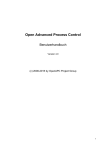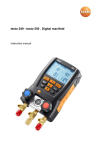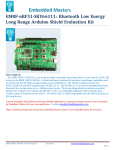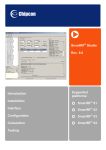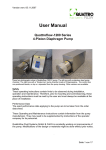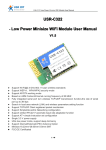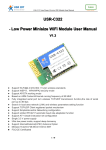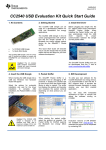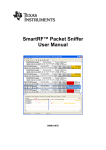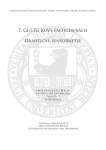Download BPI G1 User Manual - TinyOne Tutorials Electronic Projects
Transcript
Banana PI BPI-G1 BPI G1 User Manual V1.0 http://www.banana-pi.com http://www.sinovoip.com.cn 1 Banana PI BPI-G1 Catalog BPI G1 Instructions...........................................................................................................................1 Catalog ..............................................................................................................................................2 1 Introduction....................................................................................................................................4 1.1 BPI G1 ................................................................................................................................4 1.2 Main features.......................................................................................................................7 1.2 Which IDE development can use? ......................................................................................8 1.3 Which emulator debugging? ...............................................................................................8 2 Hardware Description ....................................................................................................................8 2.1 Some of the features TI CC3200.........................................................................................8 2.2 Some of the features TI CC2530.......................................................................................10 2.3 Some of the features TI CC2540/1....................................................................................10 2.4 Some of the features STM32F103CB ............................................................................... 11 3 Peripheral Interface ......................................................................................................................12 3.1 TI CC3200 part Peripheral Interface .................................................................................12 3.1.1 4-wire SDIO Interface............................................................................................12 3.1.2 Uart Interface .........................................................................................................13 3.1.3 SPI Interface...........................................................................................................13 3.1.4 I2C Interface...........................................................................................................14 3.1.5 PWM & Timer Capture channel.............................................................................14 3.16 ADC channel ...........................................................................................................15 3.2 TI CC2530 part Peripheral Interface .................................................................................15 3.2.1 Uart Interface .........................................................................................................15 3.2.2 SPI Interface...........................................................................................................16 3.2.3 PWM & Timer Capture channel.............................................................................16 3.2.4 ADC channel ..........................................................................................................17 3.3 TI CC2540/1 part Peripheral Interface..............................................................................17 3.3.1 Uart Interface .........................................................................................................17 3.3.2 SPI Interface...........................................................................................................18 3.3.3 ADC channel ..........................................................................................................18 3.3.4 PWM & Timer Capture channel.............................................................................19 3.4 STM32F103CB part Peripheral Interface .........................................................................19 3.4.1 Uart Interface .........................................................................................................19 3.4.2 SPI Interface...........................................................................................................20 3.4.3 I2C Interface...........................................................................................................20 3.4.4 CAN Interface ........................................................................................................21 3.4.5 USB2.0 Interface....................................................................................................21 3.4.6 PWM & Timer Capture channel.............................................................................22 3.4.7 ADC channel ..........................................................................................................22 4 Global Power and Ground............................................................................................................23 http://www.banana-pi.com http://www.sinovoip.com.cn 2 Banana PI BPI-G1 5 Module interconnection ...............................................................................................................23 5.1 CC3200 connection with F103..........................................................................................23 5.2 CC2540 connection with F103..........................................................................................24 5.3 CC2530 connection with F103..........................................................................................24 6 Status LEDs for each module.......................................................................................................25 7 TI CC3200 mode selection jumper ..............................................................................................25 7.1 Programming mode...........................................................................................................25 7.2 Run mode ..........................................................................................................................26 8 Button...........................................................................................................................................27 9 How to Quick Start?...................................................................................................................27 9.1 Quick start of TI CC3200..................................................................................................27 9.1.1 Download and install the software .........................................................................27 9.1.2 Configuration G1 ...................................................................................................28 9.1.3 G1 connection BPI OPENDEBUGGER ................................................................29 9.1.4 Check whether the connected BPI OPENDEBBUG..............................................29 9.1.5 Cover IAR debugger interface file .........................................................................30 9.1.6 Recompile SimpleLink library files .......................................................................30 9.1.7 Compile, download and debug routines WLAN Station........................................31 9.2 Quick start of TI CC2540/1...............................................................................................33 9.2.1 Download and install the software .........................................................................34 9.2.2 G1 connection BPI OPENDEBUGGER ................................................................34 9.2.3 BPI OPENDEBBUG check whether the software and hardware are connected....34 9.2.4 Compile, download and debug routines SimpleBLEPeripheral.............................35 9.3 Quick start of TI CC2530..................................................................................................38 9.3.1 G1 connection BPI OPENDEBUGGER ................................................................39 9.3.2 BPI OPENDEBBUG check whether the software and hardware are connected....40 9.3.3 Modifications to adapt the code for G1..................................................................40 9.3.4 Compile, download and debug routines SampleApp .............................................42 9.4 Quick Start STM32F103CB..............................................................................................46 9.4.1 G1 connection BPI OPENDEBUGGER ................................................................47 9.4.2 BPI OPENDEBBUG check whether the software and hardware are connected....47 9.4.3 Compile, download and debug routines SimpleLed...............................................48 10 Explanation ................................................................................................................................50 http://www.banana-pi.com http://www.sinovoip.com.cn 3 Banana PI BPI-G1 1 Introduction 1.1 BPI-G1 BPI-G1 is an integrated IEEE802.11 b / g / n (WIFI wireless network), IEEE802.15.4 (Zigbee), IEEE 802.11-2007 Standard (Bluetooth Low Energy4.0) development board. It is very easy to put these wireless protocol seamlessly together, you can exchange any different transport protocols, and three kinds of wireless protocols are integrated by three single-chip SOC, you can easily create your own Internet of things (IoT). WIFI part of which is the use of TI's CC3200, which is a high-performance ARM® Cortex®-M4 wireless SOC, internally integrated TCP / IP protocol stack, simply use the BSD Socket can connect to the Internet. The Zigbee is used TI CC2530, which integrates wireless capabilities and enhanced 8051 core SOC, TI after years of improvement, it is already quite mature and stable, TI's Z-stack has achieved Zigbee 2007 / Pro, you can use the 16's short address, you can use the 64-bit long address communication, face large local interconnect systems, advanced security encryption and mesh network structure can easily cope. Bluetooth 4.0 (BLE) using TI CC2540 / 1, an integrated BLE stack and enhanced 8051 core, low-power wireless SOC, at present, most mobile phones have support for Bluetooth 4.0, both as a wearable device, or mobile interactive Accessories, CC2540 can be easily completed. Meanwhile BPI G1 also incorporates a high-performance STM32 ARM® Cortex®-M3 microcontroller, which will help you deal with time-consuming data or transit, the three wireless SOC coordinated. Therefore, the use of BPI G1 can help you quickly achieve a variety of things DIY design. http://www.banana-pi.com http://www.sinovoip.com.cn 4 Banana PI BPI-G1 http://www.banana-pi.com http://www.sinovoip.com.cn 5 Banana PI BPI-G1 Hardware Specifications Items Hardware Specifications CPU STM32F103CB ARM Cortex™-M3 32-bit RISC core WIFI CC3200 device is an integrated high-performance ARM Cortex-M4 MCU and with a Wi-Fi network processor subsystem (This subsystem includes 802.11 b / g / n radio, baseband, network protocol stack and a powerful encryption engine MAC, supports 256-bit encryption in order to achieve a fast, secure Internet connection). This device contains a variety of peripherals, I2S, SD / MMC, UART, SPI, I2C and four-channel analog to digital converter (ADC). CC2540 device is a low cost, low power, true system-on-chip (SoC) for Bluetooth Bluetooth low energy applications. It enables to build a strong BLE master or slave node with very low total cost BOM. The CC2540 combines the excellent RF transceiver, the industry-standard enhanced 8051 MCU, in-system programmable flash memory, 8 KB RAM and many other powerful auxiliary functions and peripherals. Zigbee CC2530 device is a true system-on-chip (SoC) for IEEE802.15.4, Zigbee RF4CE applications and solutions. It enables the establishment of a strong network of nodes and very low total cost BOM. CC2530 combines leading RF transceiver, the industry-standard enhanced 8051 MCU, in-system programmable flash memory, 8 KB RAM http://www.banana-pi.com http://www.sinovoip.com.cn 6 Banana PI BPI-G1 outstanding performance and many other powerful features. Power Buttons LED Monitor OS Product size Weight 5V DC Reset button WiFi Bluetooth Zigbee OLED(128x64) Free-RTOS、Ti-OS、Coustom-OS 95mm X 56mm 19g What can I do with BPI-G1? 1.Smart Home.。 2.Intelligent Gateway。 3.DIY electronic control。 1.2 Main features • Multi-module integration, development board does not occupy a small space • Multi-protocol integration, to meet the Internet of things needs of various wireless connections • Rich interface, no matter which one you want to achieve functional modules can easily match • Abundant development resources, open source sharing of data and TI, ST and other major manufacturers improve the development of information • IOS and Android devices open software interface helps you quickly connect a handheld control device • Zigbee wireless integrated power amplifier section, an open area can reach as far as 3 km of intercellular communication http://www.banana-pi.com http://www.sinovoip.com.cn 7 Banana PI BPI-G1 1.2 Which IDE development can use? TI CC3200: Code Composer Studio (CCS) IAR EWARM GCC TI CC2530/CC2540: IAR EW8051 Instant Contiki STM32F103CB: IAR EWARM GCC 1.3 Which emulator debugging? TI C3200: BPI OpenDebugger TI CC2530/CC2540: BPI OpenDebugger TI CC Debugger TI SmartRF04EB TI SmartRF05EB STM32F103CB: BPI OpenDebugger JLink V8 STLink V2 2 Hardware Description 2.1 Some of the features TI CC3200 • • • • ARM Cortex-M4 core, 80MHz operating frequency Embedded memory RAM (up to 256KB) External serial flash boot loader, and the ROM peripheral drivers 32-channel direct memory access (DMA) http://www.banana-pi.com http://www.sinovoip.com.cn 8 Banana PI BPI-G1 • For advanced fast security hardware encryption engine, including AES,DES and 3DES SHA2 and MD5 Cyclic Redundancy Check (CRC) checksum • 1 SD / MMC interface • 2 Universal Asynchronous Receiver Transmitter (UART) • 1 serial peripheral interface (SPI) • 1 inter-integrated circuit (I2C) • 4 general-purpose timers, support for 16-bit pulse width modulation (PWM) mode • 1 watchdog timer • 4-channel 12-bit ADC (ADC) • Up to 12 independently programmable, reusable general purpose input output (GPIO) pins • Built-in TCP / IP stack Industry standard BSD socket application programming interface (API) 8 simultaneous TCP sockets or UCP 2 slots while TLS and SSL • Strong encryption engine for the 256 for AES TLS and SSL encrypted connections fast, secure Wi-Fi and internet connection • Base stations, access points (AP) and Wi-Fi Direct Mode • WPA2 Personal and Enterprise Security • For independent and fast Wi-Fi connection SimpleLink Connection Manager • SmartConfig technology, AP mode and WPS2, these techniques used to implement a simple and flexible Wi-Fi hotspot • Tx power 18.0 dBm @ 1 DSSS 14.5 dBm @ 54 OFDM • RX Sensitivity -95.7 dBm @ 1 DSSS -74.0 dBm @ 54 OFDM • Advanced low power mode Support real-time clock (RTC) Sleep: 4μA Low power deep sleep (LPDS): 120 μA RX flow (MCU activation): 59 mA @ 54 orthogonal frequency division multiplexing (OFDM), TX flow (MCU activation): 229 mA @ 54OFDM, maximum power Idle connections (in LPDS in MCU): 695 μA @ DTIM = 1 • Clock Source 40.0MHz crystal with internal oscillator RTC 32.768kHz crystal or external clock http://www.banana-pi.com http://www.sinovoip.com.cn 9 Banana PI BPI-G1 2.2 Some of the features TI CC2530 • • • • • • • • • • • • • • • • • • Excellent performance and low power 8051 microcontroller core with code prefetch feature 256K system programmable flash memory 8KB RAM, with a power supply in a variety of data retention Hardware debugging support The powerful 5-channel DMA Integrated high-performance operational amplifiers and ultra low-power comparator IEEE 802.15.4 MAC timer, general-purpose timers (one 16 bit, two 8 bit) IR generating circuit 32-kHz sleep timer capture CSMA / CA hardware support Accurate digital RSSI / LQI support 6 channels can be configured 12-bit ADC resolution AES security coprocessor 2 Powerful USART interface to support multiple serial protocol 1 common SPI interface 8 general purpose I / O pins (6 × 4 mA, 2 × 20 mA) Watchdog Timer Wireless Performance Adapt 2.4GHz IEEE802.15.4 RF transceiver High receiver sensitivity and robustness Programmable output power up to 4.5dBm • Low power consumption Active mode RX (CPU idle): 29mA TX Active mode in 1dBm (CPU idle): 29mA Power mode 1 (4us wake): 0.2mA Power Mode 2 (Sleep timer runs): 0.2mA Power Mode 3 (external interrupts): 0.4uA Wide supply voltage range (2V-3.6V) 2.3 Some of the features TI CC2540/1 • • • • • • • • Excellent performance and low power 8051 microcontroller core with code prefetch feature 256K system programmable flash memory 8KB RAM, with a power supply in a variety of data retention Hardware debugging support The powerful 5-channel DMA Extended baseband automation, including automatic recognition and address decoding General-purpose timers (one 16bit, two 8bit) IR generating circuit http://www.banana-pi.com http://www.sinovoip.com.cn 10 Banana PI BPI-G1 • • • • • • • • • 32-kHz sleep timer capture Accurate digital RSSI / LQI support 2 channels can be configured 12-bit ADC resolution AES security coprocessor 2 Powerful USART interface to support multiple serial protocol 1 common SPI interface 8 general purpose I / O pins (6 × 4 mA, 2 × 20 mA) Watchdog Timer Wireless Performance Suitable excellent receiver sensitivity (at 1 Mbps is -94 dBm), selectable, and barrier properties Programmable output power up to 4dBm (2540) / 0dBm (2541) • 2541 Low Power RX mode low: 17.9 mA Mode TX (0 dBm): 18.2 mA Power mode 1 (4-μs wake): 270 μA Power Mode 2 (Sleep timer open): 1 μA Power Mode 3 (external interrupts): 0.5 μA Wide supply voltage range (2 V-3.6 V) • 2540 Low Power RX mode low: 19.6 mA Mode TX (-6 dBm): 24 mA Power mode 1 (3-μs wake): 235 μA Power Mode 2 (Sleep timer Open): 0.9 μA Power Mode 3 (external interrupts): 0.4 μA Wide supply voltage range (2 V-3.6 V) 2.4 Some of the features STM32F103CB • • • • ARM Cortex-M3 core running at 72MHz 128K system programmable flash memory 20KB RAM 2 × 12 bits 1 microsecond A / D converter (up to 16 channels) Conversion range: 0~3.6 V Dual sample and hold function • DMA 7-channel DMA controller Supported peripherals: timers, ADC, SPI's, I2C and USART • 18 general-purpose programmable GPIO • 7 Timer 3 16-bit timers, each up to 4 IC / OC / PWM or pulse counter quadrature (incremental) encoder into http://www.banana-pi.com http://www.sinovoip.com.cn 11 Banana PI BPI-G1 • • • • • 16-bit motor control PWM timer, dead-time generation and emergency stop 2 watchdog timers (Independent and windows) System Timer: 24 downcounter 1 I2C interface (SMBus / PMBus) 3 USART (ISO7816 interface, LIN, infrared capabilities, modem control) 1 SPI interface (18 Mbit / s) 1 CAN interface (2.0B Active) 1 full-speed USB 2.0 interface 3 Peripheral Interface 3.1 TI CC3200 part Peripheral Interface 3.1.1 4-wire SDIO Interface http://www.banana-pi.com http://www.sinovoip.com.cn 12 Banana PI BPI-G1 3.1.2 Uart Interface 3.1.3 SPI Interface http://www.banana-pi.com http://www.sinovoip.com.cn 13 Banana PI BPI-G1 3.1.4 I2C Interface 3.1.5 PWM & Timer Capture channel http://www.banana-pi.com http://www.sinovoip.com.cn 14 Banana PI BPI-G1 3.16 ADC channel 3.2 TI CC2530 part Peripheral Interface 3.2.1 Uart Interface http://www.banana-pi.com http://www.sinovoip.com.cn 15 Banana PI BPI-G1 3.2.2 SPI Interface 3.2.3 PWM & Timer Capture channel http://www.banana-pi.com http://www.sinovoip.com.cn 16 Banana PI BPI-G1 3.2.4 ADC channel 3.3 TI CC2540/1 part Peripheral Interface 3.3.1 Uart Interface http://www.banana-pi.com http://www.sinovoip.com.cn 17 Banana PI BPI-G1 3.3.2 SPI Interface 3.3.3 ADC channel http://www.banana-pi.com http://www.sinovoip.com.cn 18 Banana PI BPI-G1 3.3.4 PWM & Timer Capture channel 3.4 STM32F103CB part Peripheral Interface 3.4.1 Uart Interface http://www.banana-pi.com http://www.sinovoip.com.cn 19 Banana PI BPI-G1 3.4.2 SPI Interface 3.4.3 I2C Interface http://www.banana-pi.com http://www.sinovoip.com.cn 20 Banana PI BPI-G1 3.4.4 CAN Interface 3.4.5 USB2.0 Interface http://www.banana-pi.com http://www.sinovoip.com.cn 21 Banana PI BPI-G1 3.4.6 PWM & Timer Capture channel 3.4.7 ADC channel http://www.banana-pi.com http://www.sinovoip.com.cn 22 Banana PI BPI-G1 4 Global Power and Ground 5 Module interconnection WIFI (CC3200), BLE (CC2540 / 1) and ZIGBEE (CC2530) are interconnected through STM32F103CB serial port, they can work alone, can also coordinate the work will be given below communication connections between the modules schematic。5.1 CC3200 connection with F103 http://www.banana-pi.com http://www.sinovoip.com.cn 23 Banana PI BPI-G1 5.2 CC2540 connection with F103 5.3 CC2530 connection with F103 http://www.banana-pi.com http://www.sinovoip.com.cn 24 Banana PI BPI-G1 6 Status LEDs for each module In each module has its own status indicators, in addition there are three status lights CC3200, the others were all one, and these status lights are controlled by the GPIO module。 7 TI CC3200 mode selection jumper 7.1 Programming mode Under the programming mode, you need to VI and VO short on power, CC3200 will receive as a writer, it will be the serial data received by the SPI mode file system writes to the external SFLASH, but the programming is completed after not running, you need to disconnect VI and VO, then on again, then it will be read in the file system SFLASH into memory and execute code. As shown in Figure。 http://www.banana-pi.com http://www.sinovoip.com.cn 25 Banana PI BPI-G1 7.2 Run mode Run mode, you need to disconnect VI and VO, then power on, CC3200 will SFLASH read from the file system into memory and run. In this mode, plug in the JTAG interface, using the IDE's DEBUG function, and the code will be downloaded from the JTAG interface to the memory to run, you can perform single-step debugging. For fast functional verification, this is the fastest way. However, after a reset circuit, CC3200 will be new to SFLASH read the file system operation. As shown in Figure。 http://www.banana-pi.com http://www.sinovoip.com.cn 26 Banana PI BPI-G1 8 Button BPI G1 has a button, which is connected to the PB3 pin F103, in the middle of a pullup resistor in parallel, when the key is pressed, the pin will be low-level information. Figure。 9 How to Quick Start? Demonstration IDE, here I will use the IAR EWARM under Windows7 and IAR EW8051, debugging emulator will use BPI OPENDEBUG.。 9.1 Quick start of TI CC3200 9.1.1 Download and install the software Download and install the following software: • CC3200 SDK Package - Assuming the default installation folder C:\ TI\ CC3200SDK_1.0.0\ • IAR EWARM(Please install the software on their own, we recommend using IAR EWARM 7.2 or later) http://www.banana-pi.com http://www.sinovoip.com.cn 27 Banana PI BPI-G1 • Tera Term (or similar software) - Tera Term link: http://en.sourceforge.jp/projects/ttssh2/releases/ 9.1.2 Configuration G1 http://www.banana-pi.com http://www.sinovoip.com.cn 28 Banana PI BPI-G1 9.1.3 G1 connection BPI OPENDEBUGGER 9.1.4 Check whether the connected BPI OPENDEBBUG BPI OPENDEBUGGER connected to the PC, and check whether the drive is installed, if you can not identify, install TI UNIFLASH, the programming software that comes with the driver. If you can identify that, please give G1 on electricity。 http://www.banana-pi.com http://www.sinovoip.com.cn 29 Banana PI BPI-G1 9.1.5 Cover IAR debugger interface file Copy the file C:\TI\CC3200SDK_1.0.0\CC3200-sdk\tools\iar_patch\armLMIFTDI.dll to folder C:\Program Files (x86)\IAR Systems\Embedded Workbench 7.0\arm\bin (Select be covered). 9.1.6 Recompile SimpleLink library files 1. Start the IAR and select File>Open>Workspace from the menu.. 2. Browse C:\TI\CC3200SDK_1.0.0\cc3200-sdk\simplelink\ewarm simplelink.eww directory and open 3. From the menu, select Project>Rebuild All to Recompile simplelink project http://www.banana-pi.com http://www.sinovoip.com.cn 30 Banana PI BPI-G1 9.1.7 Compile, download and debug routines WLAN Station 1. Open the wlan_station project by selecting File>Open>Workspace from the menu, navigating to C:\TI\CC3200SDK_1.0.0\cc3200-sdk\example\getting_started_with_wlan_station\ewarm, and opening wlan_station.eww。 2. Open the common.h file located at the path C:\TI\CC3200SDK_1.0.0\cc3200-sdk\example\common\。 3. Edit common.h to use the SSID, security type and security key of the Access Point being used. Edit the macros SSID_NAME, SECURITY_TYPE and SECURITY_KEY to contain the Access Point’s information as shown in Figure. The security types supported for this demo are WPA/WPA2 and Open. For Open security, define SECURITY_TYPE as SL_SEC_TYPE_OPEN. For WPA and WPA2 security, define it as SL_SEC_TYPE_WPA。 4.Save common.h。 5.Rebuild the wlan_station project by selecting Project>Rebuild All from the menu。 6.The debugger must be configured to download code to the device. Select Project>Options from the menu, and select the Debugger category. In the Setup tab, choose TI Stellaris as the driver, as http://www.banana-pi.com http://www.sinovoip.com.cn 31 Banana PI BPI-G1 shown in Figure, and press OK。 7.Launch Tera Term, and create a new serial connection to the CC3200 Launchpad COM port as shown in Figure。 8.In the menu, select Setup>Serial Port, and change the baud rate to 115200 as shown in Figure。 http://www.banana-pi.com http://www.sinovoip.com.cn 32 Banana PI BPI-G1 9. Click the debug icon as shown in Figure 24 to download code to the device and start debugging.Select Debug>Go from the menu or press F5 to begin execution 10.If the CC3200 successfully completes all steps, the serial output appears as shown in Figure。 9.2 Quick start of TI CC2540/1 The following operations are by CC2540 prevail, if G1 above your hands BLE chip CC2541, so in some way, your own modifications by CC2541。 http://www.banana-pi.com http://www.sinovoip.com.cn 33 Banana PI BPI-G1 9.2.1 Download and install the software Download and install the following software: • BLE Stack(Recommends using version 1.3.2, can go to google search to) - Assuming the default installation folder C:\Texas Instruments\BLE-CC254x-1.3.2 • IAR EW8051(Please install the software on their own, we recommend using IAR EW8051 8.1) 9.2.2 G1 connection BPI OPENDEBUGGER 9.2.3 BPI OPENDEBBUG check whether the software and hardware are connected BPI OPENDEBUGGER connected to the PC, and check whether the drive is installed, if you can not identify, install SmartRF Studio, he software that comes with the driver. If you can identify that, please give G1 on electricity. http://www.banana-pi.com http://www.sinovoip.com.cn 34 Banana PI BPI-G1 If the drive is normal, then check the G1 and OPENDEBBUG connection is normal. After the G1 to power, press the CC Debugger interface OPENDEBBUG next reset button.。 If the connection is normal, then the status light next to the CC Debugger interface will turn green, if it is red or other colors, please check whether it is normal or electricity on the G1 G1 is properly connected and OpenDebugger。 9.2.4 Compile, download and debug routines SimpleBLEPeripheral 1.IAR EW8051 SimpleBLEPeripheral start and open the project, select File> Open from the menu> Workspace。 http://www.banana-pi.com http://www.sinovoip.com.cn 35 Banana PI BPI-G1 2.Browse to C:\Texas Instruments\BLE-CC254x-1.3.2\Projects\ble\SimpleBLEPeripheral\ CC2540DB and open SimpleBLEPeripheral.eww。 3.Choose from the list of items CC2540。 http://www.banana-pi.com http://www.sinovoip.com.cn 36 Banana PI BPI-G1 4.When debugging code must be downloaded to the device. Select Project> Options from the menu and select Debugger category. In this setup tab, select Texas Instruments as a driver, and then click OK. Figure。 5.Click on the icon to download the program debug button on the device and enter debug mode. Figure。 http://www.banana-pi.com http://www.sinovoip.com.cn 37 Banana PI BPI-G1 6.Click Debug Step Out button on the column, enter the full speed。 7.Then open the phone BLE software, IOS (IPhone4s and above) on the LightBlue, Android (Android4.3 and above) on the Ex039BLE, refresh the list of Bluetooth, you will see a file called SimpleBLEPeripheral of Bluetooth peripherals. Figure。 9.3 Quick start of TI CC2530 Download and install the following software: http://www.banana-pi.com http://www.sinovoip.com.cn 38 Banana PI BPI-G1 • ZStack-CC2530-2.5.1a(Can go to google search to) - Assuming the default installation folder C:\Texas Instruments\ZStack-CC2530-2.5.1a - After installation is complete, go https://github.com/mark-legend/bpi_g1_zigbee_patch download hal_lcd.c file and overwrite the folder C:\Texas Instruments\ZStack-CC2530-2.5.1a\Components\hal\target\CC2530EB file with the same name • IAR EW8051(The software is compiled BLE's IDE is the same, if you have installed, then the direct use, otherwise the installation yourself, we recommend using IAR EW8051 8.1) 9.3.1 G1 connection BPI OPENDEBUGGER http://www.banana-pi.com http://www.sinovoip.com.cn 39 Banana PI BPI-G1 9.3.2 BPI OPENDEBBUG check whether the software and hardware are connected BPI OPENDEBUGGER connected to the PC, and check whether the drive is installed, if you can not identify, install SmartRF Studio,The software that comes with the driver. If you can identify that, please give G1 powered。 If the drive is normal, then check the G1 and OPENDEBBUG connection is normal. After the G1 to power, press the CC Debugger interface OPENDEBBUG reset button next。 If the connection is normal, then the status light next to the CC Debugger interface will turn green, if it is red or other colors, please check whether it is normal or electricity on the G1 G1 is properly connected and OpenDebugger。 9.3.3 Modifications to adapt the code for G1 1.Open the file C:\Texas http://www.banana-pi.com http://www.sinovoip.com.cn 40 Banana PI BPI-G1 instruments\ZStack-CC2530-2.5.1a\Components\hal\target\CC2530EB\hal_board_cfg.h, jump to about 61 lines, will be as Modified to 2.Open the file C:\Texas Instruments\ZStack-CC2530-2.5.1a\Components\mac\low_level\srf04\single_chip\mac_radio_def s.c,jump to about 300 lines, will be as Modified to http://www.banana-pi.com http://www.sinovoip.com.cn 41 Banana PI BPI-G1 9.3.4 Compile, download and debug routines SampleApp The operation requires two BPI G1 development board, and you need two OLED screens. 1.Start IAR EW8051 and open SampleApp project, select File> Open from the menu> Workspace。 2.Browse to C:\Texas Instruments\ZStack-CC2530-2.5.1a\Projects\zstack\Samples\SampleApp\CC2530DB and open SampleApp.eww。 3.Choose from the list of items CoordinatorEB。 http://www.banana-pi.com http://www.sinovoip.com.cn 42 Banana PI BPI-G1 4.When debugging code must be downloaded to the device. Select Project> Options from the menu and select Debugger category. In this setup tab, select Texas Instruments as a driver, and then click OK. Figure。 http://www.banana-pi.com http://www.sinovoip.com.cn 43 Banana PI BPI-G1 5.Click on the icon to download the program debug button on the device and enter debug mode. Figure。 6.Click Debug Step Out button on the column, enter the full speed。 7.If there is no problem, a G1 should be is a good writer. Up and running in the following figure。 http://www.banana-pi.com http://www.sinovoip.com.cn 44 Banana PI BPI-G1 8.Next, another a G1 programming development board. Choose from the list of items RouterEB。 9.Another is a G1 and BPI OPENDEBUGGER connection. After connecting, click the CC Debugger interface again next reset button, look at the status light is green, if not green, check the power supply G1 or G1 with OPEN DEBUGGER the cable is properly。 10.Click on the icon to download the program debug button on the device and enter debug mode. Figure。 http://www.banana-pi.com http://www.sinovoip.com.cn 45 Banana PI BPI-G1 11.Click Debug Step Out button on the column, enter the full speed。 12.If everything is normal, then the two G1 already up and running, you can see from the two G1 OLED screen they have connected to the。 9.4 Quick Start STM32F103CB Download and install the following software: • IAR EWARM (the software with the IDE compiler CC3200 is the same, if already installed, then the direct use, otherwise the installation yourself, we recommend using IAR EWARM 7.2 or later) • Go https://github.com/mark-legend/bpi_g1_stm32_simpleled download SimpleLed http://www.banana-pi.com http://www.sinovoip.com.cn 46 Banana PI BPI-G1 9.4.1 G1 connection BPI OPENDEBUGGER 9.4.2 BPI OPENDEBBUG check whether the software and hardware are connected BPI OPENDEBUGGER connected to the PC, and check whether the drive is installed, if you can not identify, install JLinkARM,which comes with software drivers. If you can identify that, please give G1 powered。 http://www.banana-pi.com http://www.sinovoip.com.cn 47 Banana PI BPI-G1 9.4.3 Compile, download and debug routines SimpleLed 4.Start IAR EWARM and open SimpleLed project, select File> Open from the menu> Workspace。 5.Browse to bpi_g1_stm32_simpleled \ SimpleLed and open SimpleLed.eww。 http://www.banana-pi.com http://www.sinovoip.com.cn 48 Banana PI BPI-G1 6.Click on the icon to download the program debug button on the device and enter debug mode. Figure。 6.Click Debug Step Out button on the column, enter the full speed。 8.If there is no problem, STM32 lower left corner of the LED will begin to flash lights。 http://www.banana-pi.com http://www.sinovoip.com.cn 49 Banana PI BPI-G1 10 Explanation • In the implementation of the development of wireless applications on G1 plug in antenna。 • DC power input is 5V, the development board interfaces are 3.3V VCC。 • CC3200 The three status lights above the IO IO port and port are the same。 http://www.banana-pi.com http://www.sinovoip.com.cn 50


















































